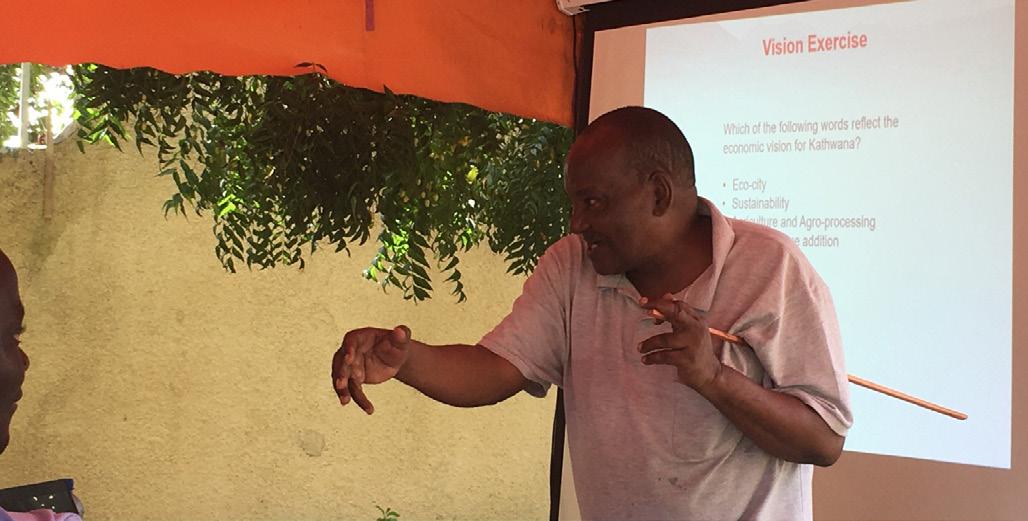
3 minute read
6.5 Inclusivity Recommendations
the Programme; Inclusion Awareness workshops delivered by the Programme, overall inclusion and poverty reduction impact achieved etc. Economic opportunities and Value Chains The Sector Action Plans (Section 4.2) present recommendations around institutional structures and capacity to successfully develop the key sectors and realise the opportunity from the VC projects. An Agri-industrial board is recommended to build cross-sector understanding on the processing ecosystem, markets and export promotion, as well as track strategic objectives. Capacity building for the Sector Action Plans incorporates the County’s educational facilities, the County Government and Municipality, the business community, local community and sectoral partners, where a business incubator is aspired to as local capacity is built.
6.5 Inclusivity
Recommendations
To ensure the Programme achieves its UEP goal of promoting enterprise development activities that enhance the employability of marginalised populations, everyone’s participation in the UEP development and implementation activities, and shared benefits across the Municipality, the following is recommended for inclusion across a 3-dimensional approach: The social dimension of inclusion
This refers to the fundamental principles of rights, dignity, equity and security for all, and it seeks to address attitudinal and information barriers to inclusion. The Programme shall continually implement inclusive stakeholder engagement which will include:
› Ensuring participation of all including the youth, PWDs, and women in the UEP’s planning, development, implementation and monitoring phases, and related activities; › Applying pro -excluded groups and pro-poor engagement methods to reach out to excluded groups in subsequent phases of the UEP, and the entire
Programme. This will ensure excluded groups that would be shy to contribute meaningfully in regular engagement fora get a chance to meaningfully participate in decision making; › Developing a SIGs-appropriate communication plan to ensure they receive Programme information in a timely manner and are involved in decision making. Such information could include key UEP dates, capacity development and job opportunities available, customised for access by the blind, deaf and other PWDs. The economic dimension of inclusion
This dimension focuses on provision of economic opportunities for all. It emphasises the ability of all, including the most marginalised, to contribute to the economy and to share in the benefits of economic growth. To achieve economic inclusion, the Programme shall ensure that it: › Specifies the percentage of its jobs and capacity development opportunities that should be reserved for qualified excluded groups. This can be done through an inclusion targeting policy.
Provision of this threshold will make it possible to achieve and monitor progress as what gets measured gets done; › Provides capacity development initiatives that are tailored around
Kathwana’s VC Projects. This will ensure trained persons are absorbed in the
VC projects during implementation for optimum job creation; › Implements the inclusive, climate resilient infrastructure proposals made in this UEP. The proposed infrastructure projects are key to supporting the VCs’ performance and the general socioeconomic welfare of the Municipality and its residents; › Implements the inclusive, climate adaptation approaches suggested in this UEP. These are supposed to be affordable to Kathwana residents and adaptable to the local conditions.
Where these are not affordable, funding measures like subsidies by collaborating with the government are proposed to avoid creating climate induced exclusion in Kathwana; › Develops ways of improving finance access for smallholder participants of all gender, age groups and (dis)ability
across the milk pressing value chain. This could be for instance through facilitating linkages with pro-women, pro-youth and pro-PWDs micro-credit programmes or organisations that can support SIGs’ investments in the value chain. Youth and Persons with Disability contacted reported lack of capital as one of the main hindrances to their participation in this value chain; › Sells the business case of inclusive supply chains to the milk processing value chain stakeholders. In most cases, milk processors, supermarkets and hotels play the lead role in this value chain. Raising their awareness through arguments on the business and human case of supporting women’s, PWD’s and youth’s participation in the milk processing chain can yield self-sustaining inclusivity impacts. An example of this could be including inclusivity targets as part of the minimum requirements for recruiting milk supply bases; › Establishes strong collaboration measures among the various stakeholders in the food processing hub value chain. These will include small holder farmers supplying the produce, collection system players e.g. in transport, agribusinesses stakeholders, consumers as well as regulatory government bodies. This will ensure sustainable returns for the hub, direct and indirect job creation, an improved food supply, a strengthened tax base and a lighter environmental footprint of food production and distribution; all of which are key to reducing poverty.






